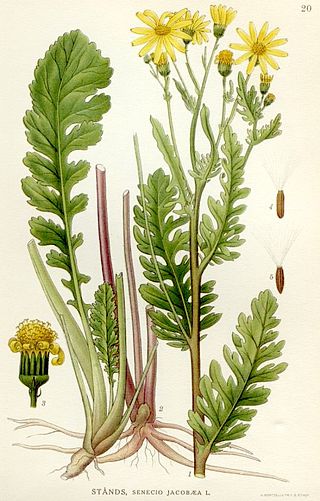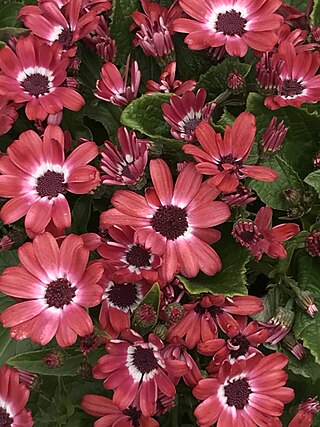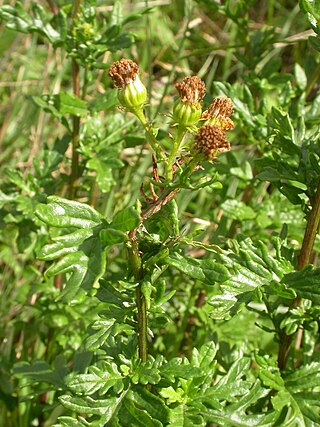
Senecio is a genus of flowering plants in the daisy family (Asteraceae) that includes ragworts and groundsels.

Jacobaea vulgaris, syn. Senecio jacobaea, is a very common wild flower in the family Asteraceae that is native to northern Eurasia, usually in dry, open places, and has also been widely distributed as a weed elsewhere.

Senecio vulgaris, often known by the common names groundsel and old-man-in-the-spring, is a flowering plant in the family Asteraceae. It is an annual herb, native to the Palaearctic and widely naturalised as a ruderal species in suitable disturbed habitats worldwide.

Senecioneae is the largest tribe of the Asteraceae, or the sunflower family, comprising over 150 genera and over 3,500 species. Almost one-third of the species in this tribe are placed in the genus Senecio. Its members exhibit probably the widest possible range of form to be found in the entire plant kingdom, and include annuals, minute creeping alpines, herbaceous and evergreen perennials, shrubs, climbers, succulents, trees, and semi-aquatic plants.

The cinnabar moth is a brightly coloured arctiid moth found as a native species in Europe and western and central Asia then east across the Palearctic to Siberia to China. It has been introduced into New Zealand, Australia and North America to control ragwort, on which its larvae feed. The moth is named after the red mineral cinnabar because of the red patches on its predominantly black wings. The species was first described by Carl Linnaeus in his 1758 10th edition of Systema Naturae. Cinnabar moths are about 20 mm (0.79 in) long and have a wingspan of 32–42 mm (1.3–1.7 in).

Pericallis × hybrida, known as cineraria, florist's cineraria or common ragwort is a flowering plant in the family Asteraceae. It originated as a hybrid between Pericallis cruenta and P. lanata, both natives of the Canary Islands. The hybrid was first developed in the British royal gardens in 1777. It was originally known as Cineraria × hybrida, but the genus Cineraria is now restricted to a group of South African species, with the Canary Island species being transferred to the genus Pericallis; some botanists also treat it in a broad view of the large and widespread genus Senecio. Some varieties are sold under the trade name Senetti.

Packera is a genus of about 75 species of plants in the daisy family, Asteraceae. Most species are commonly called ragworts or grounsels. Its members were previously included in the genus Senecio, but were moved to a different genus based on chromosome numbers, a variety of morphological characters, and molecular phylogenetic evidence.

Jacobaea maritima, commonly known as silver ragwort, is a perennial plant species in the genus Jacobaea in the family Asteraceae, native to the Mediterranean region. It was formerly placed in the genus Senecio, and is still widely referred to as Senecio cineraria; see the list of synonyms (right) for other names.

Packera aurea, commonly known as golden ragwort or simply ragwort, is a perennial flower in the family Asteraceae.

Senecio squalidus, known as Oxford ragwort, is a flowering plant in the daisy family Asteraceae. It is a yellow-flowered herbaceous plant, native to mountainous, rocky or volcanic areas, that has managed to find other homes on man-made and natural piles of rocks, war-ruined neighborhoods and even on stone walls. These habitats resemble its well drained natural rocky homeland. The plants have spread via the wind, rail and the activities of botanists. The travels of this short-lived perennial, biennial, or winter annual make it a good subject for studies of the evolution and ecology of flowering plants.

Rugelia nudicaulis, the sole species of the genus Rugelia, blooms in summer. It is a wildflower endemic to higher elevations in the Great Smoky Mountains. It is a rare species in Tennessee. First placed in the genus Senecio, then moved to Cacalia it was finally placed in a genus of its own, Rugelia. Genetic diversity in this plant, assessed using allozymes, is so low that the species may not survive changing environmental conditions.

Longitarsus jacobaeae is a species of flea beetle known as the tansy ragwort flea beetle. It is used as an agent of biological pest control against the nectar-rich noxious weed known as ragwort.
Groundsel is a common name for several plants and may refer to:

Jacobaea erucifolia, the hoary ragwort, is a species of the genus Jacobaea and the family Asteraceae.

Jacobaea paludosa, syn. Senecio paludosus, the fen ragwort, is a species of the genus Jacobaea and the family Asteraceae that can be found in northern Italy, and everywhere in Europe.

Packera musiniensis is a rare species of flowering plant in the aster family known by the common names Musinea ragwort and Musinea groundsel. It is endemic to Utah in the United States, where it is known only from Sanpete County in the Manti-La Sal National Forest.
Woolly ragwort is a common name for several plants and may refer to:
Common ragwort is a common name for several plants and may refer to:
Water ragwort is a common name for several plants and may refer to:














